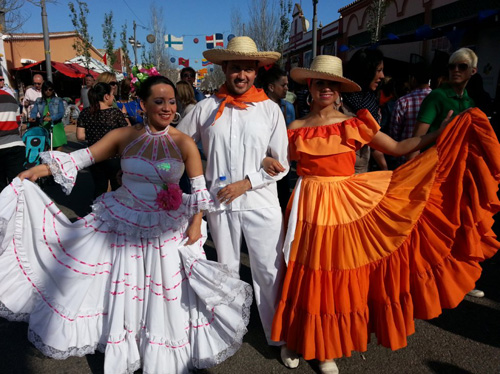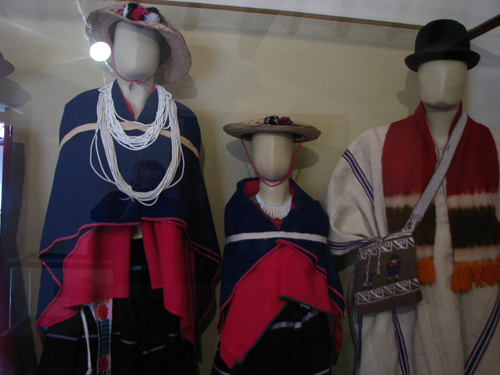 The traditional clothing of Colombia is very diverse, bright, and eccentric. It is also considered to be iconic for the whole Latin America. Besides, locals keep their clothing traditions and wear folk dresses in day-to-day life. And it shouldn't surprise you – Colombian traditional costumes are made from the natural materials; they are colorful, light, beautiful, and comfy.
The traditional clothing of Colombia is very diverse, bright, and eccentric. It is also considered to be iconic for the whole Latin America. Besides, locals keep their clothing traditions and wear folk dresses in day-to-day life. And it shouldn't surprise you – Colombian traditional costumes are made from the natural materials; they are colorful, light, beautiful, and comfy.
The climate in Colombia is various as well as their national costumes. It can be hot and humid in coastal areas, and cool and windy in mountain areas. So, locals have their own clothing traditions that suit their surroundings. Those who live at the coast often use light colorful fabrics, sombreros, and a lot of jewelry made from the natural materials. The mountain dwellers prefer ponchos, wide-brimmed hats, and floral patterns on fabric. People who live in the jungles use very small garments such as loin-cloths and small tops; they also wear jewelry made from available materials.

People in Colombian national clothing at the festival. Photo from Colombiaspanish.blogspot.com
Folk dresses in Colombia also vary according to the region of the country. Let's find out about the clothing traditions of different parts of Colombia: Andean region (territory in Andes Mountains), Caribbean region (coastal territory near the Caribbean Sea), Pacific region (territory adjacent to the Pacific Ocean), Orinoquía region (covers the territory of the Orinoco river basin), Amazon region (covers the part of the Amazon rainforest), and Insular region (comprises islands in the Atlantic and Pacific oceans).
Andean region
The garments in this region are designed due to the climate conditions of the high mountains and windy meadows. Usually, male traditional outfit consists of a shirt, trousers, sandals, and a brimmed hat. Female attire consists of a blouse, a wide skirt, sandals, and a brimmed headdress. But there are some differences in clothing according to the occupation, district of living, and etc.
The most popular is Huila dress. These costumes are worn during folk dances. The men's attire consists of a simple white shirt, trousers, a red scarf, leather belt, and a hat. Women wear a white blouse with many ruffles, a wide skirt, often with floral pattern on the fabric, and flowers in the hair.
In mountain areas both men and women use woolen poncho called "ruana".
In the coffee belt region of Andes, men use twill trousers, a printed shirt, a poncho, a handkerchief around the neck, sandals, a hat, and a bag draped over the shoulder. Local men also carry a machete at the waist. Women wear a white long-sleeved blouse, a flowing skirt with colorful floral patterns, and white sandals.
Caribbean region
This region is coastal, so the clothing of local people is light, flowing, and made from natural materials, to cope with the heat and humidity. But the costumes are also bright, richly decorated with embroidery, jewelry, colorful patterns, and flowers. Male attire consists of a colorful shirt and linen trousers (or a white shirt and trousers), a woven bag draped over one shoulder, and a sombrero or other headdress. Women use a light top and skirt, and a sombrero as well.

Man and woman in Colombian traditional costumes. Photo from Wikipedia.com
This region is a home to several indigenous groups. For example, Wayuu people live here. They keep their own traditions in clothing, crafts, folklore, and other activities. Wayuu women wear traditional loose dresses, sandals with woolen tassels, and homemade woven colorful bags.
Pacific region
The traditional costumes of this coastal region of Colombia are under the influence of the climate and history of the area. A lot of immigrants from Africa live here in knit communities. They keep their own folk and clothing traditions. Men, usually, wear loose colorful garments, and sandals made from the natural materials. Women use colorful or pastel outfits made from soft fabrics and embellished with flowers, ribbons, and other decorative elements. The patterns on fabric are often floral or polka-dot. The skirts and dresses are ankle-length. People use brimmed hats, just like many other dwellers of Colombia.
Orinoquía region
This area of Colombia is characterized by the occupation of locals. People, usually, earn their living by cattle ranching here. So, the national clothing of this area is simple, convenient and designed for the horseback riding.
But there are also attires used by folk dancers. And they are different. Men use white trousers with red or black shirt (or black trousers with white shirt), and a wide-brimmed hat made from heavy materials (because the hat is to stay put during the horseback riding). Women wear a wide knee-length skirt, rather puffy, made from white and red fabric, often with floral patterns; a 3/4 sleeve blouse with red and white ribbons; and flowers or ribbons in the hair.
Amazon region
In this region of the country, many various ethnic groups live in their small communities. They have their own clothing traditions. Mostly people of Amazonia wear not much clothing. Men and women wear loin-cloths, and some jewelry – that's all.

Vintage traditional clothing of Colombia. Photo from Mikesbogotablog.blogspot.com
Some men in Amazon region of Colombia use white trousers or wrap-around skirts to cover their body. Women wear calf-length skirts with white blouses. And both males and females use a lot of jewelry made from the natural materials: necklaces, bracelets, and earrings made from beads, wood, seashells, etc.
Insular region
The dwellers of these islands don't actually have unique clothing traditions. That's because the population historically changed several times, and today there are no people who traditionally have their communities live there for centuries. Some tribes from Colombia and Panama were the first settlers of these islands, then conquistadors came, and now many territories have a status of a national park. Wild animals mostly inhabit this region of Colombia.



https://www.lifeder.com/trajes-tipicos-boyaca/
If you mean, why Colombian clothing looks like it does, then yes, there is a reason. Local outfits were formed according to climate conditions and weather, typical for the region. For instance, those who live on the coast, often use light and colorful fabrics and sombreros – to protect their bodies and heads from the harsh sun. The mountain dwellers prefer ponchos (excellent clothing for colder mountain areas) and wide-brimmed hats (for protection from rain or snow). People who live in the jungles use very small garments such as loin-cloths and small tops.
But personally, I’m not sure about the wide ruffled skirts.